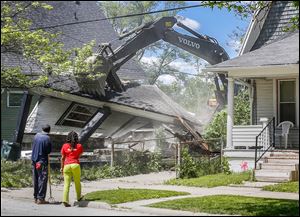
Land Bank completes phase-one demolition
838 structures torn down at cost of $6.8M
5/24/2014
Walter Young, left, and Erica Besteder watch Toledo Streets, Bridges, and Harbor Division workers demolish a house at 660 Greene St. Ms. Besteder lives in the house at right.
The Lucas County Land Bank marked a watershed moment of its short existence Friday by doing what it‘s best known for: knocking down decrepit houses.
The final three houses of the group’s phase-one demolition effort came down along Greene Street in South Toledo, bringing the total to 838 structures torn down at a cost of nearly $6.8 million since August, 2012.
That’s almost three times as many as a comparable year. The record year for demolitions before the land bank’s creation was 300, Wade Kapszukiewicz, Lucas County treasurer and chairman of the land bank’s board of directors, said.
Half of the money for phase one came from the Ohio Attorney General‘s Office, he said. The other half came from money generated by the land bank, Mr. Kapszukiewicz said.
Now, he said, the land bank is eager to move into phase two, which will result in the demolition of 600 more eyesores, he said.
The bonus for the next round is that the group does not expect to spend any of its own money, Mr. Kapszukiewicz said.
Mr. Kapszukiewicz said the upcoming work is being funded by a $6 million grant from the Ohio Housing Finance Agency, an independent state agency formerly part of the Ohio Department of Development. Its mission is to help low and moderate-income residents in Ohio obtain housing and secure their investments.
Reducing blight improves property values, but it also inspires people at risk of losing homes nearby to avoid foreclosure, said David Mann, the land bank’s president.
“It makes neighborhoods more attractive and livable,” Mr. Mann said.
The land bank, also known as the Lucas County Land Reutilization Corporation, was created in August, 2010. It typically acquires houses to demolish them or, when possible, converts them to other uses or resells them. It also has a fund that helps bridge financing gaps for development projects.
Vacant homes are a liability threat, targets for vandalism and fire. They also can be what Councilman Tyrone Riley described as a “magnet for crime.”
Mr. Riley said the land bank is a useful tool in remaking Toledo.
Mayor D. Michael Collins said the land bank’s efforts reflect a strategy many of America’s legacy cities are using to make a comeback. The mayor attended an event this week in Cambridge, Mass., about the challenges for these cities, including Toledo.
They mayor said removing blight is a step forward, whether the site is redeveloped or converted into a park, ball field, or other type of green space.
The 838 demolitions in phase one include 746 by the city of Toledo and 92 by private contractors.
The land bank is funded by an increase in penalties for delinquent property taxpayers.
The county's acquisition of properties has been facilitated by a change in law that allows the treasurer to take possession of vacant and abandoned homes and land within 14 months of the owner first defaulting on the property taxes. The process used to take between three and five years, but now the land bank can acquire the properties without waiting for them to go through a sheriff's auction.
Contact Tom Henry at: thenry@theblade.com or 419-724-6079.